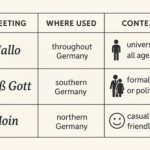
German greetings might sound simple on the surface – a quick Hallo and you’re off. But under that simplicity lies one of the most socially charged areas of everyday communication: choosing between formality and informality. In Germany, the way you say “hello” can subtly signal status, age, professional boundaries, and how well you know someone. Saying the wrong greeting at the wrong time might not spark outrage, but it will quietly mark you as out of step with German norms.
This article guides you through Germany’s complex etiquette of formality and informality – when to use Hallo, Guten Tag, Hi, or even Na?, and how your greeting shapes first impressions.
Why Greetings in Germany Are About More Than Words
German society is known for clear distinctions – rules, titles, roles, and social boundaries are carefully maintained. That same thinking applies to how people speak to one another. The language itself draws a line between du (informal “you”) and Sie (formal “you”), and greetings often signal which side of the line you’re on.
Getting it right can earn you respect. Getting it wrong can create an awkward pause – or worse, make someone feel disrespected.
The Spectrum of German Greetings
Let’s break down common greetings in Germany and how they’re typically used:
Formal Greetings: Use with strangers, elders, and in professional settings
- Guten Morgen (Good morning)
- Guten Tag (Good day)
- Guten Abend (Good evening)
- Grüß Gott (used in the South)
- Wie geht es Ihnen? (How are you? – formal)
Informal Greetings: Use with friends, peers, or younger people
- Hallo (Hello)
- Hi (Borrowed from English)
- Na? (Very casual, like “Hey” or “What’s up?”)
- Hey (Youthful and casual)
- Servus, Moin, Griaß di (regional informals)
Which greeting you choose – and how you say it – gives cues about your relationship to the person you’re addressing. In Germany, erring on the side of formality is usually safer, especially if you’re unsure.
How Hallo Differs from Hi in German
Both Hallo and Hi are informal greetings, but there are subtle differences:
- Hallo is widely accepted and understood across all age groups. It’s appropriate for informal but polite interactions.
- Hi is newer and trendier – more likely used among younger people or in casual digital communication. It may feel out of place in professional or traditional environments.
So, while Hi might be common among teenagers or in texts, Hallo works better when speaking to someone new in a casual setting.
Formality Rules by Context
Workplace
- When meeting colleagues for the first time: use Guten Tag
- With close coworkers: switch to Hallo or even Hi over time
- In email greetings: use Sehr geehrte/r… or Guten Tag unless informality is established
Social Settings
- Meeting someone at a party: Hallo or Hi depending on the crowd
- Greeting a friend of a friend: Hallo is safest until you’re invited to be informal
- Group settings (e.g. classes, tours): greet everyone with Hallo zusammen (“hello everyone”)
Public Places
- In shops: Guten Tag or Hallo depending on the tone of the business
- To strangers: Guten Tag or regional formal greetings like Grüß Gott
- On the street or hiking paths: say Hallo or a regional greeting like Servus or Moin
For regional variations, see:
➡️ Saying Hello in Germany: The Rules of Grüß Gott, Moin, and Hallo
The Du/Sie Divide: How Greetings Reflect Language Hierarchy
In German, you address people with either du (informal) or Sie (formal). This distinction strongly influences your greeting.
- If you’re on Sie terms, use formal greetings like Guten Tag
- If you’re on du terms, you can safely use Hallo, Hi, or Na?
- Switching from Sie to du requires mutual agreement – called per Du werden
- The switch often comes after a shared drink, time spent together, or an offer: “Wollen wir uns duzen?” (“Shall we use du with each other?”)
Being too quick to use du (or too casual a greeting) can be seen as overstepping boundaries, especially with older people or authority figures.
The Polite Power of Guten Tag
Guten Tag may sound stiff or old-fashioned to younger ears, but it remains one of the most reliable greetings in Germany – especially in situations where you’re unsure of the relationship or expected formality.
Use Guten Tag:
- In interviews
- With hotel staff
- Entering a doctor’s office
- Meeting parents of a partner for the first time
- Interacting with strangers over age 50
Think of Guten Tag as your linguistic suit-and-tie – it’s rarely inappropriate and always respectful.
The Exceptionally Casual “Na?”
Na? is the minimalist greeting of modern German. It’s extremely informal, used mainly among friends, and implies familiarity. It’s the equivalent of a raised eyebrow or a nod – saying more with less.
Use Na? only:
- With close friends
- In casual chats
- When you’ve already established informal rapport
Avoid Na? with strangers or in work-related settings unless your relationship is clearly informal.
What Happens When You Get It Wrong?
Most Germans are tolerant of foreign accents and greeting mix-ups – especially if you’re clearly not a native speaker. However, using an overly casual greeting in a formal setting may:
- Come off as presumptuous or disrespectful
- Signal unfamiliarity with German norms
- Make people hesitant to engage more deeply
You’re unlikely to be corrected directly, but social cues will tell you you’ve missed the mark – a longer pause, a confused smile, or a formal reply.
Tips to Master German Greeting Etiquette
- Default to formal unless you’re sure you can be casual
- Observe what others say in the setting – and mirror it
- In doubt, say Guten Tag – it works almost everywhere
- Match your tone to your greeting – a cheerful “Hi” feels out of place if said like a robot
- Let the other person set the tone – especially in professional or age-diverse settings
Quick Reference Table
| Greeting | Formality | Context | Use With |
|---|---|---|---|
| Guten Tag | Formal | Shops, workplaces, meetings | Strangers, elders, professionals |
| Guten Morgen | Formal | Morning time, formal conversations | Anyone (before ~11 am) |
| Hallo | Neutral | General use, informal social settings | Friends, acquaintances |
| Hi | Informal | Youth culture, casual texts | Peers, friends |
| Na? | Very Informal | Peer-to-peer, close friends | Only in relaxed settings |
| Servus, Moin | Informal | Regional, friendly | Depends on region |
Politeness in German Starts with the Right Greeting
In Germany, greetings are more than just pleasantries – they’re the first move in a subtle dance of respect, boundaries, and cultural awareness. Saying Hallo instead of Guten Tag may seem like a minor detail, but to a German ear, it’s a signal about who you are and how you relate to others. Mastering the balance between formality and friendliness will open doors, warm conversations, and help you navigate German society with confidence.
Want to learn how greetings reflect deeper cultural identity? Read:
➡️ What Your German Greeting Says About You: Identity, Region, and First Impressions
➡️ Du or Sie? Navigating Formality in German Conversation
Or return to the full guide:
➡️ Saying Hello in Germany: The Rules of Grüß Gott, Moin, and Hallo







